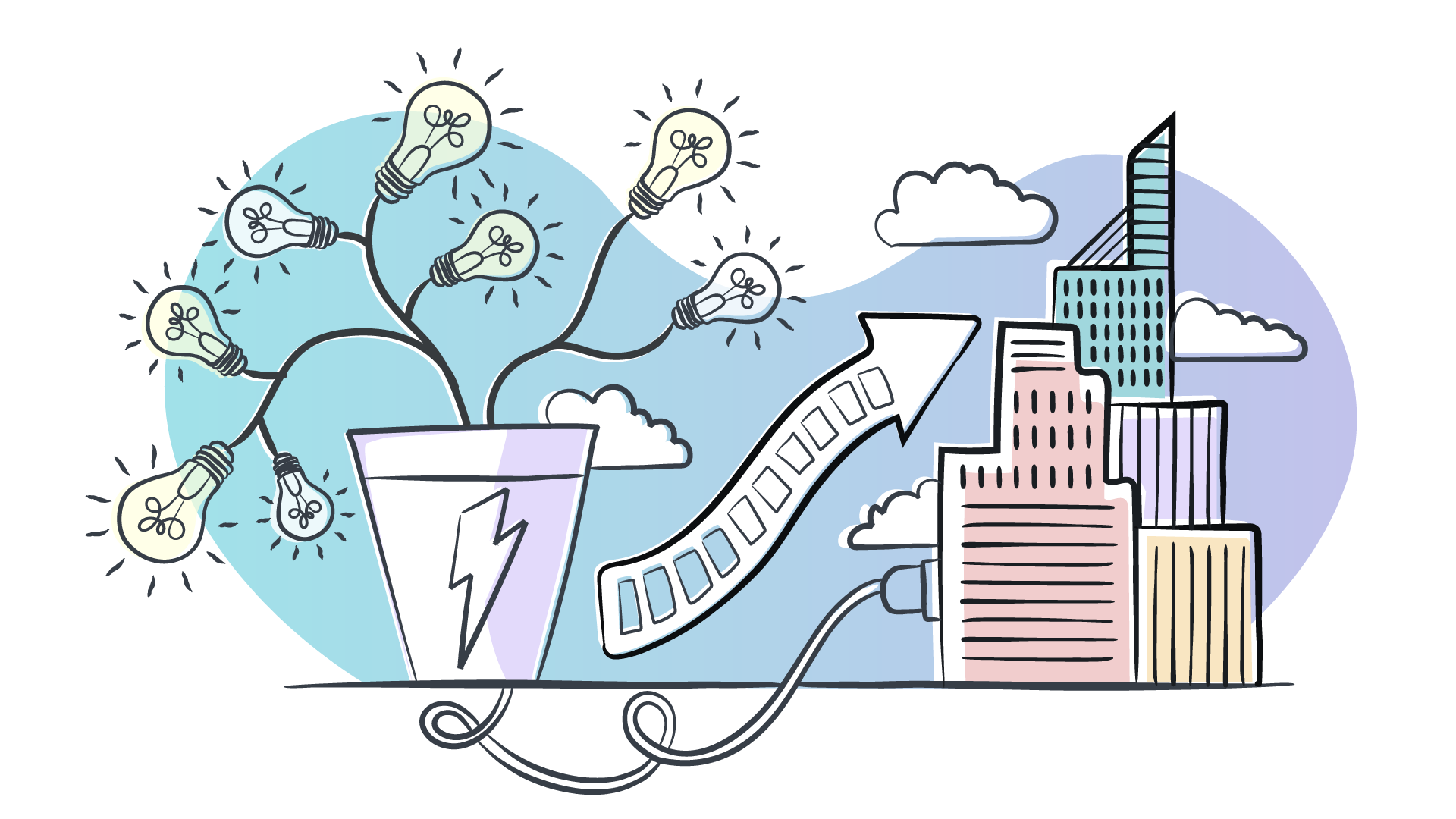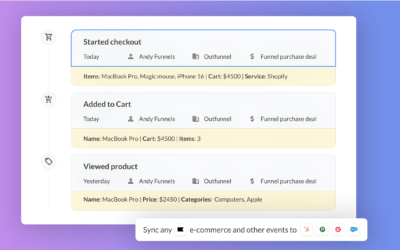If you’re a B2B marketer or salesperson, feeding the lead machine probably keeps you up at night. To find a formula that works for your business, you need to experiment and try out different B2B lead gen methods.
If the never ending list of tactics are leaving you feeling overwhelmed and the sales figures in your spreadsheets are far from making you smile, you’re in the right place.
Below, you’ll find a detailed list of lead generation strategies with tips, tricks, and examples to put things into context and set you up for success!
P.S. Find a TL;DR summary in the end of the post if you’re in a rush.
What is lead generation?
To start with the basics, let’s get the definition of lead generation out of the way. According to Webopedia:
But before we get to talking about lead generation channels and strategies, let’s take a brief look at the importance of lead generation.
Lead generation is key to business success
It’s noisy out there.
Flashy billboards, aggressive sales pitches, and expensive commercials are still around, but you have more marketing channels than ever before.
There’re social media campaigns, email marketing, Reddit AMAs, podcasts, the list goes on.
So, it’s not easy to stand out and find your ideal customer.
You need a solid strategy to attract, engage, and convert your leads into customers. That’s where lead generation comes in.
Here’s how it can benefit your B2B company.
- Target your ideal customers: The problem with full-page magazine advertisements? It’s not segmented enough. Lead generation empowers you to target specific buyer persona demographics, and collect information about their needs and preferences. The result? You can tailor your sales and marketing strategy to make sure you’re speaking to the right people at the right time.
- Generate brand awareness: You won’t make any sales if people don’t have a way to find you. Lead generation helps you get your name out there, educates your audience about your products and services, and builds credibility by showing your leads that you’re an expert in your niche.
- Get valuable business data: The more leads you generate, the more information you have on your target audience. You’ll understand their wants and needs and what your competition is doing, giving you the upper hand to better position yourself in the market.
Quality leads = more customers: You instantly attract higher-quality leads when you ditch the spray and pray approach and start using targeted lead generation strategies. The more people finding your business who have the problem you solve, the easier it is to sell your product or service.
In a recent research report we put together with Copper, the Google-recommended CRM, B2B sales, and marketing leaders shared their key metrics for business success.
The number 1 metric? Quality of leads.
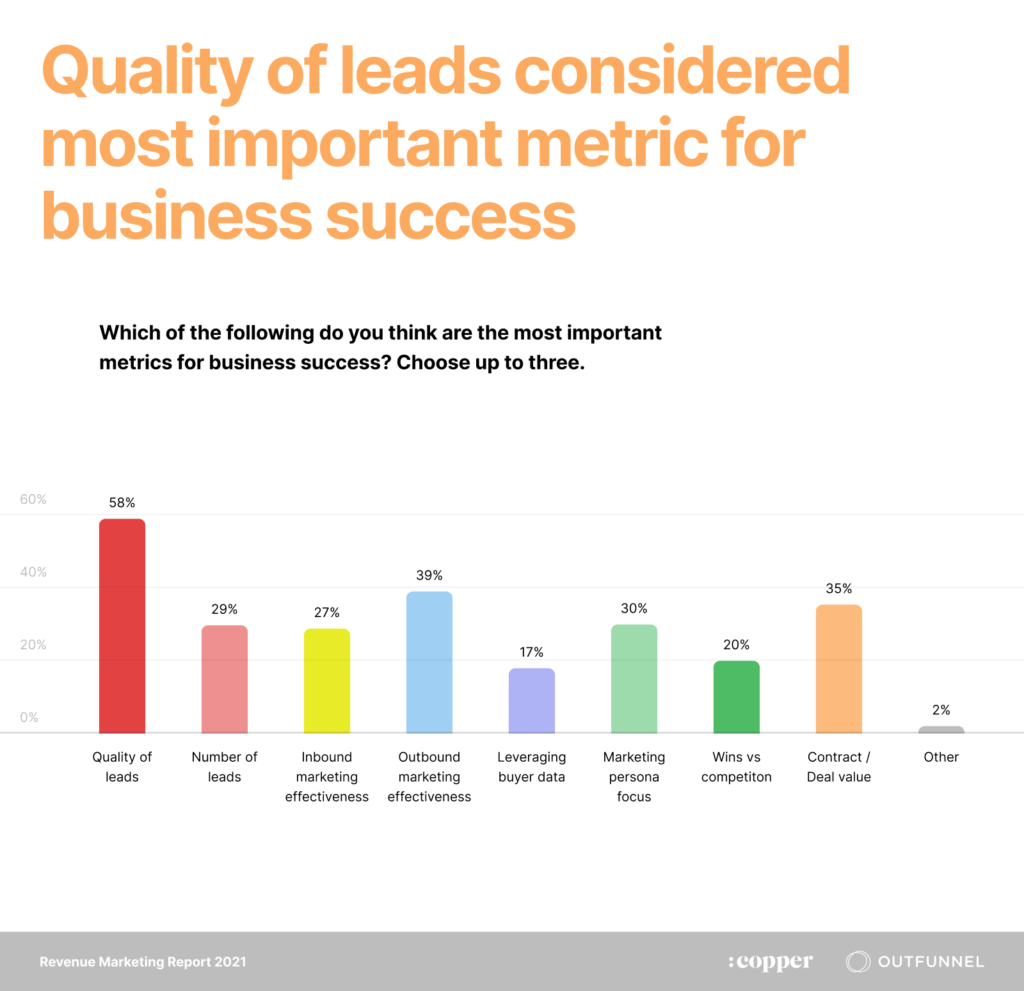 See more: Revenue Marketing Report
See more: Revenue Marketing ReportWhen you talk to your sales and marketing, it’s also important to distinguish between MQL (marketing-qualified lead) and SQL (sales-qualified lead), to make sure you’re on the same page.
But where do B2B companies get high-quality leads?
So, with this list, I’m not saying, “do all of these things and $$$$.” I’m saying build your lead generation strategy around your target audience, ability, and budget.
Without further ado, let’s jump in and look at online and offline B2B lead generation strategies.
The best-performing B2B lead generation strategies
Looking for leads online? Here are some ideas to generate leads in the digital world. And while some of them may seem obvious, sometimes it’s worth reminding ourselves that the answers are less complicated than they might seem.
1. Good ol’ email marketing
I have a lot of conversations with business people who are looking for some input on their marketing and, generally, it goes something like this:
“I don’t really have enough time or money for marketing, what can I do to get more leads without having to drop a lot of cash?”
My response: content and, most importantly, email.
According to marketing automation tool Emma, 59% of marketers point to email as being their best channel for revenue generation. Okay, if you have someone on your email list of subscribers, they’re already potentially a lead, but email is vital for establishing (with little hands-on sales work and lead scoring in place) whether those marketing leads are actually viable.
Sign up for our free crash course on B2B email marketing
take Content brings in the volume, email helps you sort the wheat from the chaff. And, yes, you can use cold email outreach to generate sales leads. Done properly (read: not spamming people), it can absolutely get those leads flowing in.
While a piece of content brings in the search volume, an email helps you sort the wheat from the chaff. When done correctly (read: not spamming people), it can absolutely get those leads flowing in.
And, speaking of cold emails.
2. If you do cold email, put in the effort
Cold email is probably the most abused channel these days. Smart email marketers know to put in the effort, if and when they use cold email.
The first thing to work on is building a quality list of email addresses. You can use a tool like Voila Norbert for that or explore other ways to find people’s email addresses.
And then comes the crucial part: properly cleaning the email list before even going near any email sending tools.
In fact, the only way to get good results with cold email is to first build a high-quality list. For example, Outfunnel recently launched the company’s first cold email campaign and the 33-51% open rates and 3-6% engagement rates (respectable results, no?) were direct results of the effort that went into cleaning and vetting the list.
Then, your emails need to stand out. In Outfunnel’s cold email experiment, personalization proved to be effective but at the minimum you can be “creative”.
Don’t be afraid to be different. Unusual, even. I would much rather drop in some quirkiness and have someone message me back, calling me out on using “quirky lead generation tactics” than be lost against a background of beige noise.
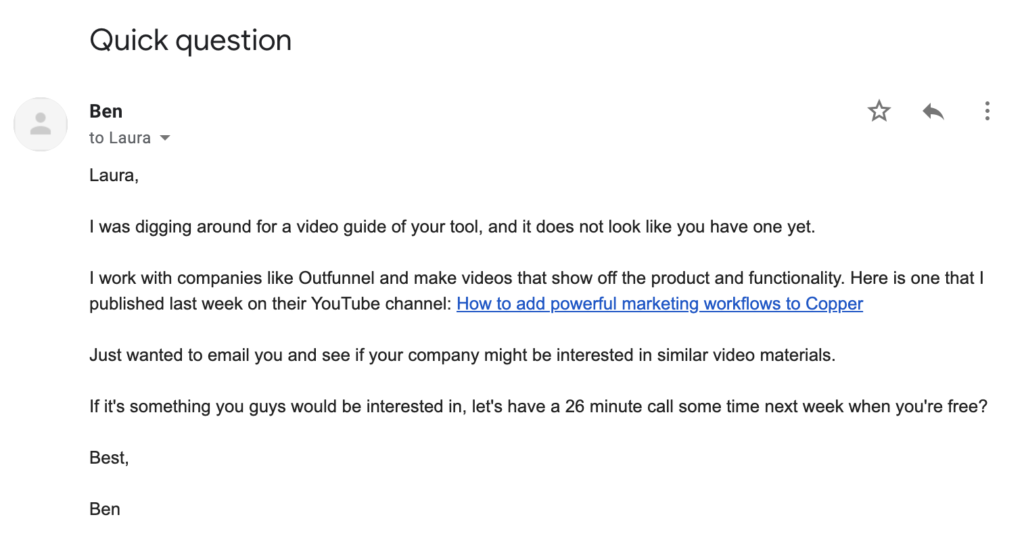
In this particular example, I said “let’s have a 26 minute call” to the cold leads, rather than a round number, and ended up getting called out on it. But the overall response rate went up by around 10-15% versus the “let’s have a quick call” version.
Don’t let the MBA write your cold outbound emails. Not that there’s anything wrong with MBA’s in particular, it’s just you often find a certain type of cold email, full of “synergizing business goals” and buzzwords coming from MBA-types. Let your creative people get their hands on the email copy and let them be creative.
Use images, gifs and experiment with pattern interrupts, something that breaks the regular pattern of a cold email and grabs the attention of cold leads.
3. High-quality content marketing (think eBooks, whitepapers and webinars)
Valuable content can be awesome for B2B lead generation, but it comes with an armful of caveats. Number one being that content works best for nurturing MQLs, i.e. someone in the beginning of the buyer’s journey, rather than for building a list of SQLs. Additionally, good quality content arguably requires an order of magnitude more planning, resources, and just hard work than, say email.
High-quality case studies, infographics, eBooks and white papers can sometimes take months to put together, if you include the time it takes to gather data, analyze it then package all your findings into something actually useful.
Not to mention webinars or podcasts!
I’m not trying to scare you off using content to generate inbound leads, you absolutely should be doing it. Just spend a little bit more time planning it. Think “would I hand over my email address for this?”. Ask other people the same question.
A particular favorite is taking some data that you may have within your business, anonymizing it, then doing a deep dive analysis.
Another favorite is taking whatever original know-how you have and turning that into a resource. For example, Outfunnel’s CEO created a B2B email marketing course last year. He has 20+ years of experience in B2B marketing, and from customer interactions, it was clear that many need guidance.
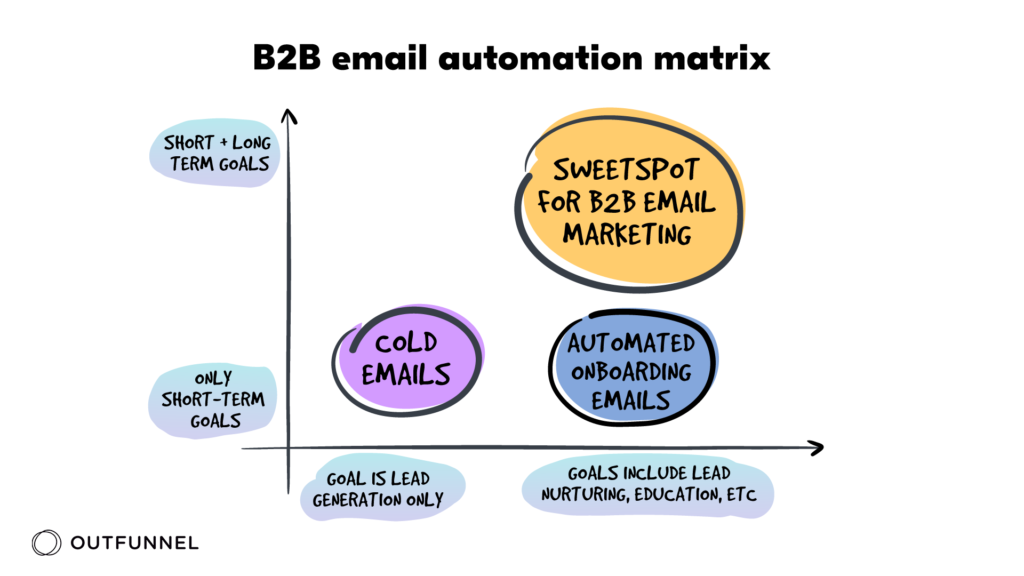 The kind of original nuggets you’ll find in Outfunnel’s B2B email marketing course.
The kind of original nuggets you’ll find in Outfunnel’s B2B email marketing course.While the course did take several weeks to put together and polish, it does serve two goals really well.
First, Outfunnel’s customer success team can share it with all the users who have less experience with email marketing, helping them win more. And second, as word about it spread, referrals delivered more than 400 highly qualified warm leads in just a few months.
And beyond driving leads, it likely did a lot to help with brand awareness!
If you think all of this sounds too daunting or you don’t have resources available in-house, reach out to some freelancers and ask for help. There are armies of stellar marketers out there just itching to help you.
I’m not trying to scare you off using content to generate inbound marketing leads. You absolutely should be doing it. Just spend a little bit more time planning it. Think, “would I hand over my email address for this?”.
4. Create a course
Another favorite is taking whatever original know-how you have and turning that into a resource.
As we mentioned earlier, Outfunnel’s CEO created a B2B email marketing course last year.
While the course did take several weeks to put together and polish, it does serve two goals really well.
First, Outfunnel’s customer success team can share it with all the users who have less experience with email marketing, helping them win more. And second, as word about it spread, referrals delivered more than 400 highly qualified warm leads in just a few months.
And beyond driving leads, it likely did a lot to help with brand awareness!
If you think this sounds too daunting or don’t have resources available in-house, reach out to some freelancers and ask for help. There are armies of stellar marketers out there just itching to help you.
5. Get better at blogging
A common complaint I hear, mainly from sales-focused people is that their blog doesn’t generate enough leads. Either it’s not getting enough traffic, or it’s getting traffic that’s not converting into business results.
Well, here’s a slightly unhelpful, but somewhat necessary tip for you:
Be better.
Have a plan, and execute it well. Stop regurgitating other peoples’ opinions and start sharing your own experience. Write posts as a person, to be read by other people.
Great content doesn’t happen overnight, but with persistence, it really can be the pillar of your B2B lead generation efforts.
A well thought out content marketing plan featuring an SEO-optimized blog will bring you the traffic and help them towards the bottom of the funnel at the conversion rates you like. Just don’t forget to plug in some CTAs to help convert visitors into leads.
6. Tap into online social media communities (Facebook groups, LinkedIn, Reddit)
Generally speaking, social media marketing has a bad rap when it comes to B2B lead gen.
The truth is, social networks can be a great source of leads if you know where to look. And I strongly recommend looking into online communities on social media platforms where your target customers hang out.
More often than not though, a lot of these groups will forbid directly promotional content — always check the rules before posting something (on Reddit you can take a look at the sidebar, usually).
So how can you use these online communities for lead generation? Well, hunt down a few groups that seem relevant to the problem you’re trying to solve. Think “where do my prospective customers hang out?”. Take a look, go through the post history — make sure it’s not all spam, for example.
Then get subscribed and start engaging. Post questions, answer other people’s questions. A lot of groups you will actually find decision-makers posting looking for exactly the kind of thing you’re offering. Just direct message them (and make sure to reply to them in the comments, otherwise — on Facebook at least — they might not see the message).
Let’s take Web Design as an example.
I threw “web design and development” into the Facebook Groups search and these are the groups I found:
Best Web Designing & Development in WordPress And OpenCart
Web Development & Web Designing
There were a couple more but they were private (always worth asking to join though). Of those two, within the last 24 hours (at the time of writing) there were 4 different requests for web design and development services.
Literally, potential leads, just sitting there.
Struggling to identify relevant social media sites and influencers?
Allow me to introduce you to Sparktoro. It’s an audience research tool that does all the heavy lifting for you.
Drop a topic, hashtag, website, or social media account relevant to your audience into the search box and you’ll instantly get a list of:
- Top hashtags used
- Top words in bios
- Frequently used phrases
- Top websites visited
- Most followed social media accounts
- Youtube channels, podcasts, and press accounts
That’s not all.
Sparktoro also gives you action steps on how to use this data in a campaign.
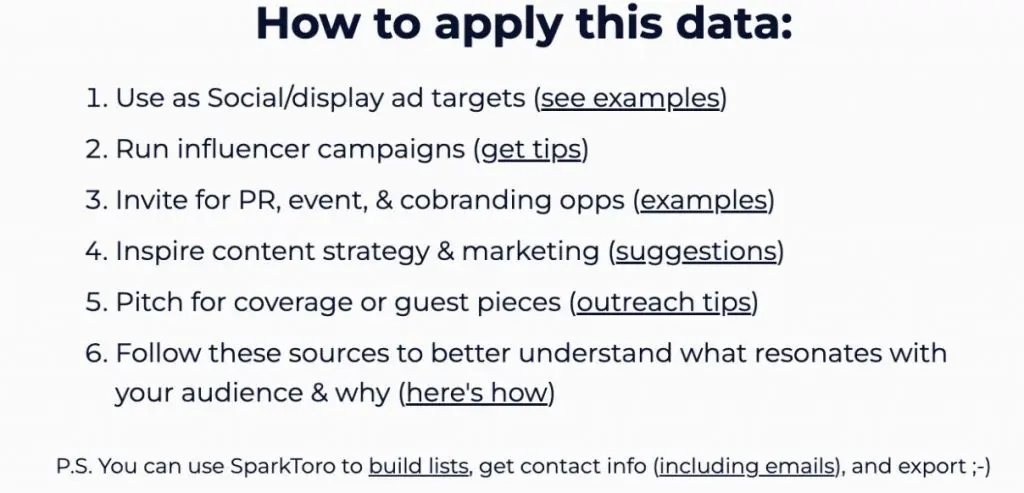
7. Build your own online community
Not only can having your own social network community bring in business leads as prospective customers, it also allows you to really cement yourself as a thought leader.
My biggest piece of upfront advice here though would be—if you’re looking at this as a lead generation tool—don’t approach it from a branding perspective at all. Name it something not linked to your company at all.
Post as yourself, build your personal brand. Your own community is the perfect place to share unique content and target people who are likely having the specific problem you’re looking to solve.
What’s more, if you’re an early-stage, SaaS-type business, it’s often the perfect way of nurturing early adopters than you can later become your “brand champions” or influencers.
A word of caution though; communities like this will take time to grow. They, much like the content you will need to produce to feed them, are an investment in their own right. And once they get to the sort of scale you need for them to become a legitimate source of leads, you might even need to have a dedicated person to manage the community itself.
8. Launch a super-basic MVP
This one is mainly aimed at early-stage SaaS businesses but not exclusively. There are many examples of service-based companies, like agencies, switching over to a product (I used to work at one!).
Launching a pared-down version of your product early on kills many birds with a single stone.
You can start generating qualified leads. You get to test product-market fit. You get to figure out what sort of key features you should prioritize based on the actual needs of a potential buyer.
An example that springs to mind is web-based video SaaS, Loom. It was super-basic when they first went to market, with only a small range of features. It was free as well, with their argument that they didn’t think the business landscape was ready for them to start asking for money.
However, it didn’t stop them from going out and gathering up sales leads.
And, of course, Outfunnel.
When Outfunnel first launched, it pretty much did a single thing. Connected Mailchimp to Pipedrive. The longer-term vision was much more fully-featured than that.
But why wait potentially years to build it, burning through money, when you can start generating warm leads, and securing your business, while at the same time letting the market guide the product development process?
9. Fix your website
Your homepage is your shop window. It’s your opportunity to grab a visitor’s attention and turn them into a customer. While a typo here and there might not necessarily be the end of the world, making sure your website is fully functional and loads quickly is an absolute must…
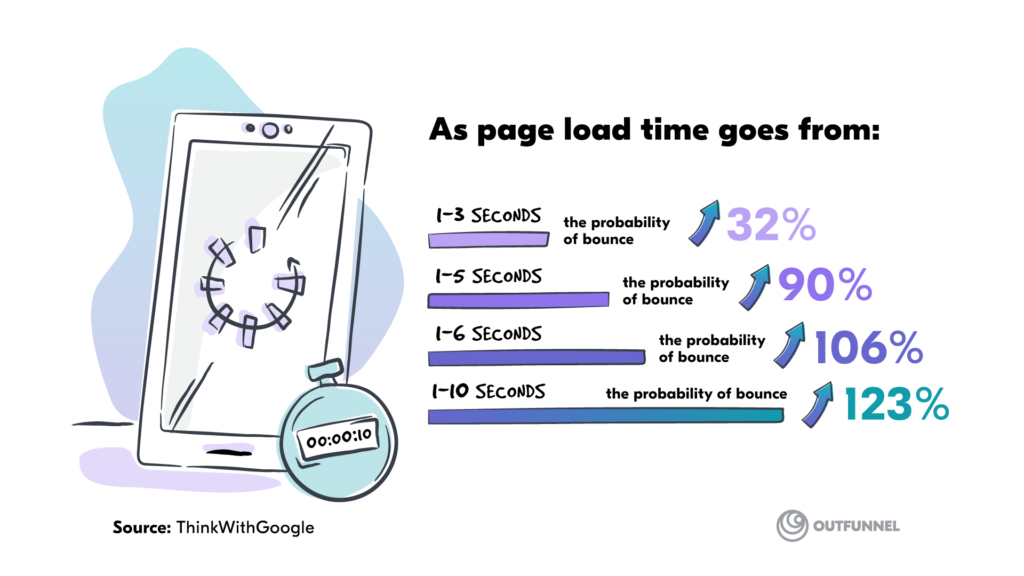
And, while we’re on the subject of loading times… It’s probably no surprise that the longer your page takes to load, the higher the probability your visitors will just up and leave before they get to the good stuff.
This is worth a whole post on its own but here’s a quick tip. Head to Google’s PageSpeed Insights and see how your home page (and most important pages) score.
Keep in mind that how your site fares here has a direct impact on how it ranks. Which directly impacts your ability to generate B2B leads.
10. Create a form to capture leads
Speaking of generating leads, don’t skimp on the “Contact” page. Your websites needs to make it ridiculously easy for someone to get in touch with you.
Set up a simple form to capture leads information and use Outfunnel’s Elementor Forms integration to seamlessly sync form fills to your CRM.
Another option is to use a chatbot. Use it as an interactive FAQ and feature suggested articles or encourage visitors to send you a message and strike up a conversation.
It’s a low effort way to get contact information out of a user and start nurturing the lead further down your funnel.
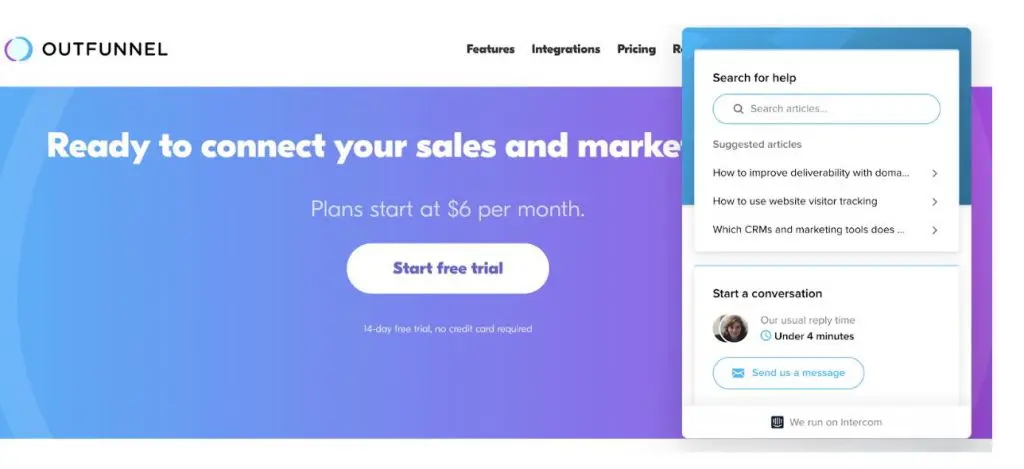
11. Optimize for your mobile traffic
Google’s made a lot of noise over the last few years about the importance of mobile. In fact, the PageSpeed Insights score actually prioritizes mobile performance.
The graph below is for ad revenue (rather than pure “traffic”) but it still paints a pretty clear picture. If your sales and marketing approach is treating mobile as the bastard step-child of desktop, then you’re missing out.
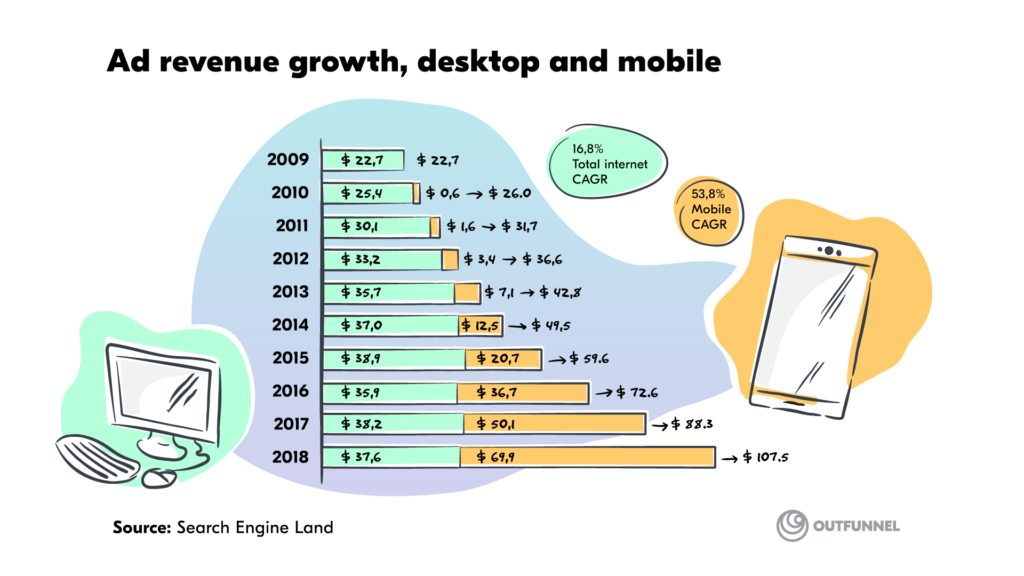 Source
SourceEven simple stuff, like making sure your site is clear and easy to navigate on a handheld device. Make sure forms, you know, work. Many B2B sites on mobile are an assault on the eyes, with myriad pop-ups for consent, live chat tools, several similar call-to-action buttons competing with each other and interstitials. Yes, you can get away with that on desktop, but on mobile you have a lot less real estate to play with.
Maybe consider changing out that screen-filling lead capture form that appears on every page with something that appears “in-feed” as they scroll through your article or landing page?
12. Hunt down competing leads
What do I mean by competing leads? Well, for example, say you had a lead that fell through—an agency based in New York.
If you’ve got a little bit of technical or analytical skills, you can create competitor reports. These are based on the profile of that particular business and build a targeted list of who you can go after.
I won’t go into too much detail, because frankly, this SEMrush article on the topic covers everything you really need to know.
13. Start using Google ads
Google ads.
The pinnacle of paid, B2B lead generation, right? Everyone’s throwing their cash at Google to get their brand to that all-important top spot. This must be because it delivers an awesome return on ad spend, right?
Yes, but only if you can nail your strategy. Then, you’ll end up with a potent lead generation engine powering your business.
Here are some tips for optmizing your Google Ads to bring in high-quality B2B leads:
- Find high intent keywords: High intent keywords are proof the searcher is ready to make a purchase. These phrases are worth the money whereas TOFU keywords aren’t as the user is still in the research phrase. An example of an high intent keyword is “best CRM” or “best lead generation tool”.
- Use negative keywords: It’s an effective way to increase your lead conversion rate and get rid of unqualified clicks.
- Use Google Ad Remarketing: It will help your B2B business stay at the top of user’s minds (even when they’re researching your competitors).
Here’s an in-depth guide on how to set up Google Ads for B2B lead generation. It goes into detail on optmizing your account and specific strategies for getting the most out of PPC.
14. Try social media ads and other PPC display ads
Much like their text-based counterparts, banner (or display) ads across almost any channel can be a viable B2B lead generation source, but they take a good deal more effort.
They still need the same attention to detail when it comes to time, targeting, and tracking. But unlike text-only ads, display ads only really work when you have a great creative too.
Producing great banner ads depends on the number of resources your marketing team has at its disposal. More specifically, whether they can come together with sales reps to figure out what the best messaging should be, what offer you might be able to use, then go out and make something great.

An example of a PPC remarketing display ad by Outfunnel.
B2C display ads are pretty much a requirement. But with B2B, things are a little more complicated.
If you have a single-person marketing team and a handful of salespeople, steer clear of sinking a lot of time and money into display ads.
If you have some budget and want to try something with a relatively low effort, then the first step could be retargeting your site’s visitors with some high-quality lead magnet content.
And if you want to go all-in with PPC, consider getting a marketing agency specialized in paid acquisition to help you out.
15. Better quality (and more) backlinks
While I am still on the topic of SEO (search engine optimization) tips that can help you land more leads, I’d be foolish not to mention backlinks.
If you want your good quality content and landing pages to start generating you leads, you need people to be able to find it. You can pay to promote it (more on that in a second), but really, for the best return, you want a load of organic visitors reaching your content.
And, well, backlinks are, arguably the single most important factor when it comes to how your content ranks.
So, how do you get more backlinks, while keeping them decent quality?
Well, you can pay someone. There are a lot of services out there where you can hand over some cash in exchange for links from domains of varying “authority”. This can be kinda sketchy though, to be honest.
A few of the most common ways of getting backlinks, are:
- Guest posting: offer to create a blog post for other blogs, then use that to link back to your own site.
- Broken links: use a tool to find anchor text containing your keywords where the destination URL is no longer available. Reach out the author and point out the broken link while suggest your own as a replacement.
- Relevant outreach: reach out to bloggers, content creators, B2B marketers etc who’ve done posts containing products or services similar to your own and ask to be included. This happens a lot with SaaS companies creating “best of” lists. In my experience, if you start chatting with them you’ll have a very strong chance that they’ll add a link for you.
So, while backlinks by themselves aren’t to be delivering leads, without them your lead generation content is likely to be dead in the water.
16. Give away your product or service
One of the biggest names in digital marketing got their early traction by giving away a free tool: HubSpot.
While it wasn’t their core product, it was valuable enough for people to be willing to hand their contact details over.
The first tool they gave away was a website grader. Then they rolled out more and more. Of course, this was paired with a pretty feature-rich trial that was just extensive enough for an early business to build its sales pipeline.
Then they nurtured these marketing leads, with seemingly endless content, to convert them into paying customers.
17. Build authentic relationships with the right people on LinkedIn
When it comes to social selling, LinkedIn is the creme-de-la-creme of B2B leads.
Why?
It’s the go-to social media platform for business professionals.
While other platforms are where people share videos of their cats and consume entertaining content, LinkedIn is where professionals go to connect.
If you’re in the B2B niche, your target audience and the key decision-makers are only a connection request away.
How do you generate leads on LinkedIn? Focus on building relationships by providing value first.
- Create thought leadership content: Publish an article on an industry hot topic or start a discussion with a feed post.
- Join relevant groups: Ask and answer questions to build authority and position yourself as a go-to expert.
- Build quality connections: Reach out to the right people and build an authentic relationship. You don’t need to ask for the sale right away.
- Use the LinkedIn Sales Navigator tool: You’ll get instant lead recommendations, real-time insights on leads like job changes or if someone is mentioned in the news, and how to best connect with a prospect via your company’s network.
Get LinkedIn leads automatically to your CRM
Deep integrations with Pipedrive, Copper, Salesforce, and HubSpot CRM
18. Start asking for referrals and testimonials
Referrals, aka social proof, is one of the most powerful lead generation strategies for B2B companies.
Why?
Your current customers do all the heavy lifting for you.
Think about it.
If you feel strongly about something (positive or negative), you want to spread the word.
When you have a delicious meal at a restaurant or an incredible user experience, you most likely share it with your inner circle. Especially if a friend, family member, or colleague mentions having the same problem.
By making referrals part of your lead generation strategy, you’ll instantly access:
- The trust factor: We listen to people we trust. If something is working for someone we know, we are more inclined to try it.
- Your target audience: People don’t refer products or services to the wrong audience or look up reviews unless they’re specifically looking for that content.
- Lower cost acquisition: You don’t need to spend money to generate customer referrals. You just need to delight people. Incentives like a referral program or a discount for a review are more cost-effective than running PPC ads.
In a study by Heinz Marketing, companies with referral programs reported 40% of their leads coming in from referrals.
Want a piece of that cake?
- Create a referral program that encourages and rewards your customers.
- Ask for referrals from your existing base when someone is satisfied or compliments you.
- Screenshot comments on social media posts and use them on your website and marketing materials.
- Ask and reward customers for leaving a review on sites like G2 Crowd.
Next, let’s look at some offline B2B lead generation ideas.
Offline B2B lead generation strategies
All of the ideas and examples so far have been online lead generation. But what if you want to take your lead generation process to the real world?
Maybe you’re a single-person show and don’t have an army of marketers to help you? Or you don’t have the resources to build a detailed 6-month content plan to start generating high-quality leads?
Well, you can always hit the pavement.
19. Just show up
There’s a great anecdote about how fellow Estonian startup-turned-unicorn, Bolt got their first customers in the early days.
Their founder, Markus Villig needed to find taxi drivers to add to their platform, a ridesharing app. So, every day he went down to the taxi ranks in Tallinn and started knocking on cab drivers windows, asking them if they wanted to sign up.
In some cases, he got some pretty hard no’s, but he persevered. He got his early leads that were vital to the ultimate success of the business.
He got some pretty hard no’s in some cases, but he persevered. He got his early leads that were vital to the business’s ultimate success.
 Markus Villig, youngest founder of a billion-dollar company in Europe. Image source
Markus Villig, youngest founder of a billion-dollar company in Europe. Image sourceThe point is sometimes, whether you’re a very early-stage startup, or a more established business, sometimes there’s a lot of value in just turning up. You don’t need to necessarily sell on the spot, you can just get them signed up for more info.
This in particular is a great example of how you can turn the standard “marketing first, then sales team steps in” approach of the sales funnel. The whole process should be owned by both marketing and sales teams together.
In this instance, sales tactics would work better to harvest the new leads. Then, marketing can step in to do a bit of lead nurturing, building up trust, before sales steps back in to seal the deal.
20. Pick up the phone
Cold calling may seem a bit, well, icky to some, but I wouldn’t discount it as a potentially effective lead generation campaign strategy. Start with using an email finder plugin to make sure you have the most up-to-date contact information.
Research your prospects before picking up the phone, so you can answer that all-important question:
“How is this thing going to help me?”
Ideally, you should have some sort of script, at least to open with, and use it as a sort of guide throughout the call. Think of less a script and more as a kind of cheat sheet.
Then as you get more experienced, you’ll be able to be much more dynamic on each cold call.
It has a pretty dodgy reputation and it isn’t for everyone, but if you have the gift of the gab, then don’t be afraid to pick up the phone.
21. Go to better events (and do them better)
Lead generation is most businesses’ top priority when going to events. In this, your marketing and sales teams must be working in perfect harmony. Both need to share insights to figure out which events to attend.
Depending on your industry, closing deals on the floor at a tradeshow might be a bit of a stretch. Instead, use it as an opportunity to get sales to have a conversation with prospects, then pass their details onto marketing so they can nurture them if they need it.
And don’t forget, if you’re paying to attend an event, you’ll have access to the contact database more often than not. Don’t waste that.
If you’re looking for some insights on how to handle post-event marketing and follow-ups, we got you. Check out this comprehensive email marketing teardown, full of useful pointers and best practices.
Important bonus content: how to qualify leads
You have leads coming in. Now what?
If you’re processing your leads manually or wasting time on poor-quality leads, you have a lead qualifying problem.
The solution?
Implement a lead scoring system that automates the process while you sleep.
What is lead scoring?
Lead scoring is a process where you assign points to a lead. The bigger the number, the hotter the lead.
In a nutshell, it tells you a lead’s buying intention without any guesswork.
Once someone hits your point threshold, your sales automation will kick in, and a sales rep is notified to reach out and seal the deal.
Want to dive deeper into the topic? Our ultimate lead scoring guide goes over everything you need to know, from the business benefits to setting up lead scoring in three easy steps.
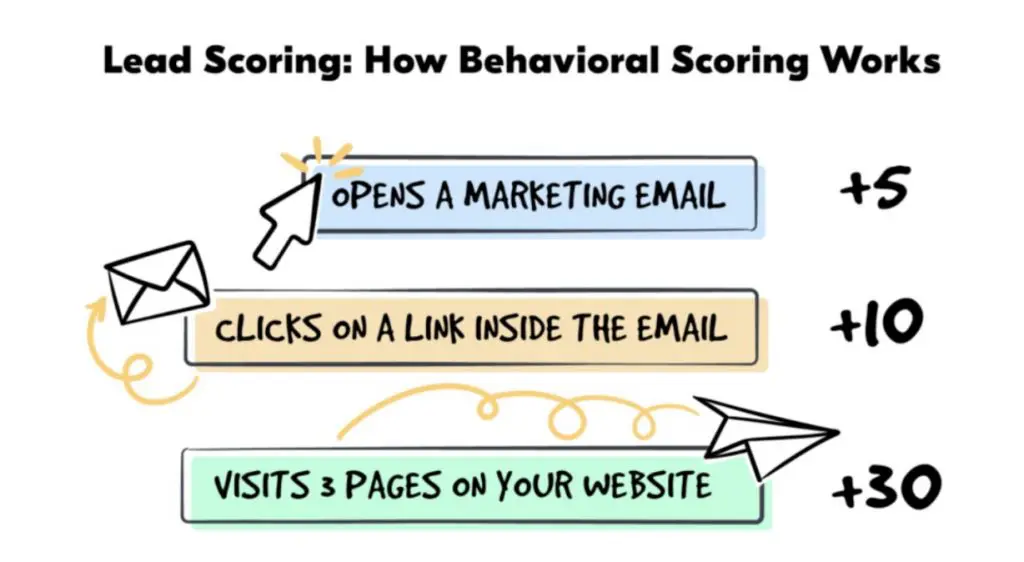
Meet our Lead Scoring Feature
Oh, and if you’re looking for a tool to automate qualifying and disqualifying leads, we humbly suggest you look at our lead scoring software first.
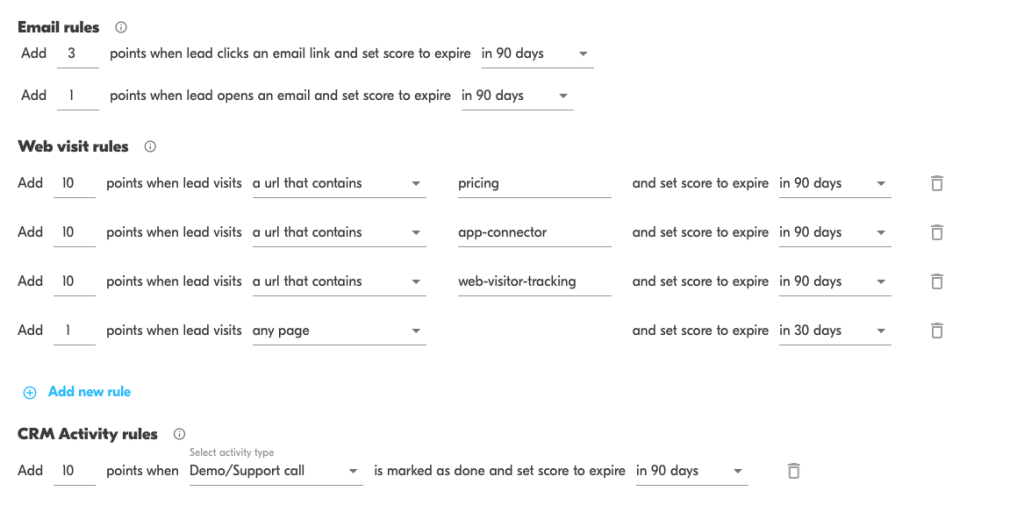
Our lead scoring feature can calculate lead scores based on:
- Email engagement from popular platforms such as Mailchimp, ActiveCampaign, Sendinblue, and Hubspot
- Website visits
- Activities from your CRM tool
You can have each of these signals “decay” to make sure sales are not served dead-end leads.
Try our lead scoring feature (and the rest of platform) free for 14 days.
B2B Lead generation trends to watch for 2023
The problem with B2B lead generation trends? The life cycle.
Things come and go, and what we are left with are the lead generation strategies that actually make an impact and generate quality leads.
Here are three examples of lead generation trends with staying power:
Account-based marketing
ABM isn’t another buzzword or fad.
It’s a growth strategy where marketing and sales collaborate to create personalized buying experiences for a set of high-value accounts.
It nips the problem of marketing casting a wide net and handing potential leads over to sales that never materialize.
With AMB, your sales and marketing teams work together to target a defined list of prospects based on the value they’ll add to your business.
You’re no longer focusing resources on generating the highest volume of leads but running campaigns to attract and convert the most profitable leads into customers.
Hyper-personalization
Hyper-personalization goes hand-in-hand with ABM.
When you use your data to make your product or service feel like it’s tailor-made for the problem someone is experiencing, it automatically:
- improves the customer experience
- helps you gain a competitive advantage
- improves your content performance
- helps you understand your customers better
These concepts align with effective lead nurturing, CX, and ABM.
Personalization doesn’t only benefit your inbound lead generation process.
Consumers are demanding it.
A report from SmarterHQ found that 72% of consumers only engage with personalized marketing messages, and 90% are willing to share behavior data for lower prices and a more effortless shopping experience.
Multimedia thought-leadership content
Not on board with the thought-leadership train?
Here’s why you should grab your ticket and join the ride:
- 89% of decision-makers say thought leadership content improves brand perception.
- 90% agree it increases respect for organizations.
- 89% agree it increases the perception of a brand’s abilities.
But that doesn’t mean you can hop on LinkedIn, hit publish on an article, and call it a day.
You need a multi-dimensional strategy to reap the lead generation rewards of thought-leadership content.
Neil Patel has built a thriving YouTube community where he shares digital marketing insights. When you combine it with 86% of marketers agreeing video content is effective for generating leads, it’s easy to see why.
If video content isn’t your thing, consider podcasts. Almost 60% of US consumers listen to audio content, and 55% of listeners have purchased based on a podcast ad.
How to Measure The Success Of Lead Generation Efforts
It’s easy to get caught up in vanity lead generation metrics.
Impressions, click-through rates, outreach volume, bounce rate, etc., are often listed as top lead-gen KPIs, but there’s one problem.
These metrics don’t tell you anything about lead generation.
If you want a better measure of your efforts, focus on qualified lead volume. Instead of giving you data on the output of your sales team, it tells you about revenue, which is the ultimate purpose of lead generation.
The TL;DR of lead gen
In a hurry? Here’s a recap of what to bear in mind when considering different lead generation strategies:
- Don’t panic if you don’t know exactly where your leads are coming from.
- Remember the “7 P’s”: Prior preparation and planning prevent piss poor performance.
- High-quality content marketing and automated email marketing are likely to be where you want to focus your efforts.
- Tradeshows have taken a hit, but they will be back. Spend this downtime perfecting your event (and post-event) sales process and marketing strategy.
- Google search ads are worth it only if you invest time. Fix your targeting, and have nailed your tracking, otherwise you’re probably burning money.

